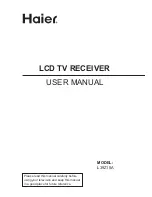
Kramer Electronics Ltd.
KIT-400
– Protocol 3000
86
Function
Description
Syntax
Parameters/Attributes
Example
CPEDID
Copy EDID data from
the output to the input
EEPROM.
Destination bitmap
size depends on device
properties (for 64 inputs
it is a 64-bit word).
Example: bitmap
0x0013 means inputs
1,2 and 5 are loaded
with the new EDID.
In certain products
Safe_mode is an
optional parameter. See
the HELP command for
its availability.
COMMAND
#CPEDID
edid_io
,
src_id
,
edid_io
,
dest_bitmap
<CR>
or
#CPEDID
edid_io
,
src_id
,
edid_io
,
dest_bitmap
,
safe_mode
<CR>
FEEDBACK
~nn@CPEDID
edid_io
,
src_id
,
edid_io
,
dest_bitmap
<CR><LF>
~nn@CPEDID
edid_io
,
src_id
,
edid_io
,
dest_bitmap
,
safe_mode
<
CR><LF>
edid_io
–
EDID
source type
(usually output)
1
– Output
src_id
– Number of chosen
source stage
For HDBT:
1
– Def. 1080P
2
– Def. 4K2K(3G)
3
– Def. 4K2K(3G-4:2:0)
4
– User1
5
– User2
6
– Output
For HDMI:
1
– Def. 1080P
2
– Def. 4K2K(3G)
3
– Def. 4K2K(3G-4:2:0)
4
– Def. 4K2K(6G)
5
– User1
6
– User2
7
– Output
edid_io
–
EDID destination
type
(usually input)
0
– Input
dest_bitmap
– Bitmap
representing destination IDs.
Format: XXXX…X, where X is hex
digit. The binary form of every hex
digit represents corresponding
destinations.
0x01
– for HDBT.
0x02
– for HDMI
safe_mode
– Safe mode
0
– device accepts the EDID as is
without trying to adjust
1
– device tries to adjust the EDID
(default value if no parameter
is sent)
Copy the EDID data from the
Output 1 (EDID source) to
the Input:
#CPEDID
1
,
1
,
0
,
0x1
<CR>
Copy the EDID data from the
default EDID source to the
Input:
#CPEDID
2
,
0
,
0
,
0x1
<CR>
DISPLAY?
Get output HPD status.
COMMAND
#DISPLAY?
out_index
<CR>
FEEDBACK
~nn@DISPLAY
out_index
,
status
<CR><LF>
out_index
– Number that
indicates the specific output: 1
status
– HPD status according to
signal validation
0
– Signal or sink is not valid
1
– Signal or sink is valid
Get the output HPD status of
Output 1:
#DISPLAY?
1
<CR>
HDCP-MOD
Set HDCP mode.
Set HDCP working
mode on the device
input:
HDCP supported -
HDCP_ON [default].
HDCP not supported -
HDCP OFF.
HDCP support changes
following detected sink -
MIRROR OUTPUT.
When you define
3
as
the mode, the HDCP
status is defined
according to the
connected output in the
following priority: OUT
1, OUT 2. If the
connected display on
OUT 2 supports HDCP,
but OUT 1 does not,
then HDCP is defined
as not supported. If
OUT 1 is not
connected, then HDCP
is defined by OUT 2.
COMMAND
#HDCP-MOD
stage
,
stage_id
,
mode
<CR>
FEEDBACK
~nn@HDCP-MOD
stage
,
stage_id
,
mode
<CR><LF>
stage
– Input/Output
0
– Input
1
– Output
stage_id
–
Input number:
1
– HDBT IN
2
– HDMI IN
Output number
1
– HDMI OUT
mode
– HDCP mode
Input:
0
– Off
1
– On
Output:
2
– Follow input
3
– Follow output
Set the HDBT input HDCP-
MODE of HDBT input to Off:
#HDCP-MOD
0
,
1
,
0
<CR>
HDCP-MOD?
Get HDCP mode.
Set HDCP working
mode on the device
input:
HDCP supported -
HDCP_ON [default].
HDCP not supported -
HDCP OFF.
HDCP support changes
following detected sink -
MIRROR OUTPUT.
COMMAND
#HDCP-MOD?
stage
,
stage_id
<CR>
FEEDBACK
~nn@HDCP-MOD
stage
,
stage_id
,
mode
<CR><LF>
stage
– Input/Output
0
– Input
1
– Output
stage_id
–
Input number:
1
– HDBT IN
2
– HDMI IN
Output number
1
– HDMI OUT
mode
– HDCP mode
Input:
0
– Off
1
– On
Output:
2
– Follow input
3
– Follow output
Get the input HDCP-MODE
of HDMI input:
#HDCP-MOD?
0
,
2
<CR>









































